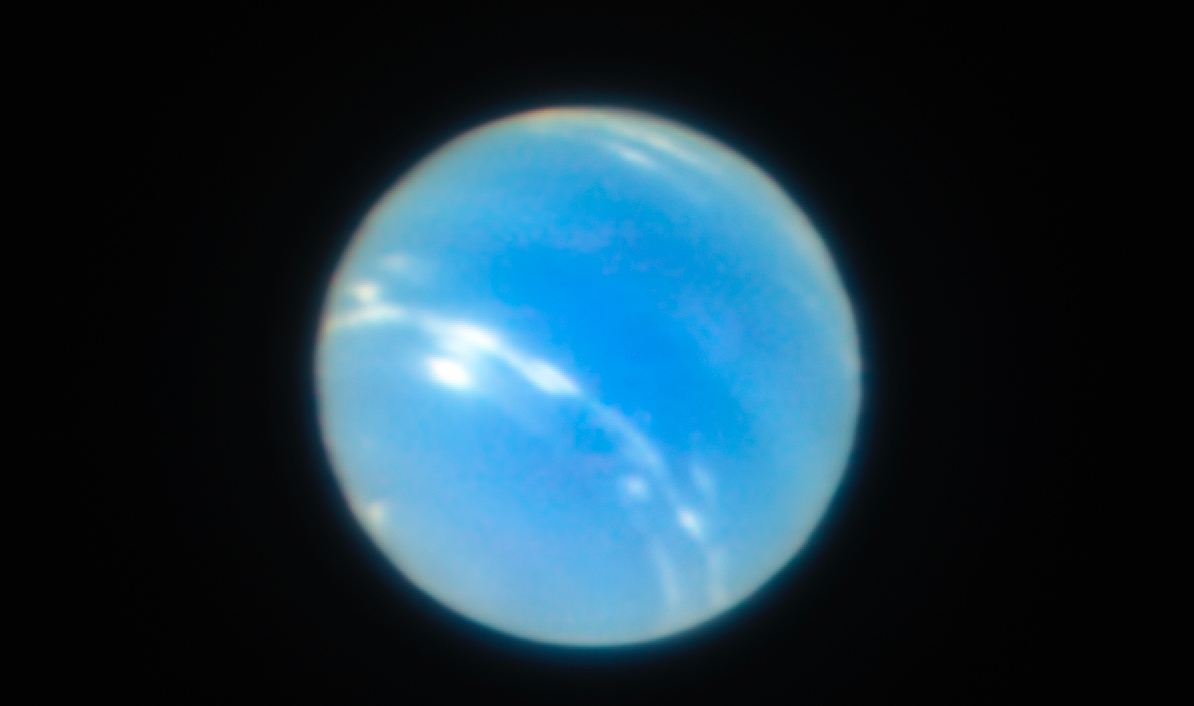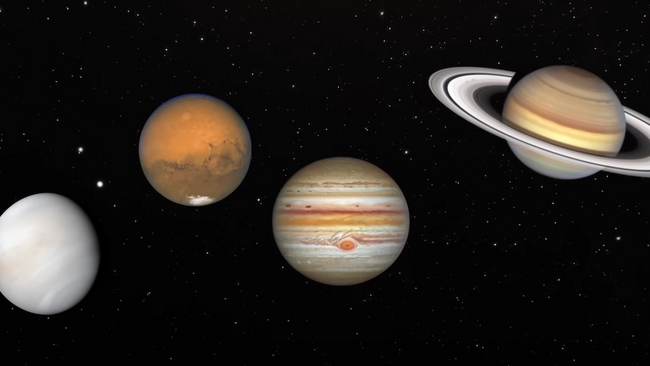No, those aren’t Saturn’s rings! This is the first (stunning!) image of planet Neptune by the new Webb telescope, showing off several narrow rings on our outermost planet. Here’s Bob Berman’s latest post about the news—plus, some facts about the outermost planet.
What is Neptune?
The eighth and farthest planet from our Sun, Neptune is an ice giant that is enormous enough to fit 58 planet Earths inside if it were hollow. But it’s not hollow at all. The part seen with backyard telescopes—its upper cloud layers—are hydrogen and helium with a little methane added for variety.
Why is Neptune Blue?
It’s this methane—commonly called natural gas—that helps make the planet blue, since it absorbs the red section of the sunlight hitting it. But that blue is tough to find.
Neptune is the only planet that can’t be observed with the naked eye, and even an expensive backyard telescope only shows it as a tiny disk. That’s because, though it’s four times Earth’s diameter, it’s so far away!

Credit: ESO’s Very Large Telescope/P. Weilbacher (AIP)
How Far is Neptune?
Neptune is located 30 times more distant from the Sun than Earth is, so that it only appears the size of a quarter dollar coin held up 1 ½ miles away from you.
If you were on Neptune, the Sun would look so small and faint that high noon would appear as dim twilight. Such a teensy disk is technically resolvable by good backyard telescopes, but its two arcsecond diameter makes it barely distinguishable from the many little smudgy twinkling background stars in the dim constellation of Aquarius.
That blue color is a better give-away. Still, how would you locate that faint 7.7 magnitude dot?
Best Bet to View Neptune
This month is when it’s closest to Earth and at its brightest of the entire 2022. And your best bet to see Neptune (with a telescope) might be coming up on October 7, 2022. That’s when it’ll be floating three degrees (or six moon-widths) directly above the nearly-full Moon. Point your telescope to that spot and you’ll see it.
The New Webb Image of Neptune
But we’re bothering with Neptune another reason. The new James Webb telescope recently published a cool infra-red photo of the ice giant that’s been widely circulated in the mass media, allowing all of us to see the last planet!

Credit: NASA, ESA, CSA, Joseph DePasquale (STScI)
That image depicts its rings very well. This was not easy, since they don’t show up at all in ordinary photographs, not even with the Hubble Space Telescope. But their dust particles catch enough of the Sun’s warmth to make it glow in infra-red light, which is Webb’s specialty.
As seen by the Webb telescope, Neptune does not appear blue but opalescent against a black sky, with a few whitish rings. Where there are methane-ice clouds, the planet reflects sunlight in bright streaks and spots; in places where the methane gas has started to absorb the light, the planet is quite dark.
How Many Moons Does Neptune Have?
Neptune has 14 known moons. And the Webb telescope captured seven of them: Galatea, Naiad, Thalassa, Despina, Proteus, Larissa, and Triton.

Credit: IMAGE: NASA, ESA, CSA, Joseph DePasquale (STScI)
Do you see the very bright “star” in the Webb image? This point of light is not a star but is Neptune’s largest moon, Triton. What you’re seeing are diffraction spikes. Covered in an icy sheen of frozen nitrogen, Triton reflects an average of 70% of the sunlight that hits it (and is brighter than Neptune itself).
What Makes Neptune Different?
As it circles the sun every 165 years, Neptune spends about 13 years in each zodiac constellation, and it’s just beginning its prison sentence in Aquarius, one of the dimmest of them all.
So what makes Neptune special? Four things. It’s the third most weighty planet, after Jupiter and Saturn. Second, it’s the fourth largest, since Uranus is slightly bigger even though it weighs a bit less. Thirdly, it’s the coldest planet in the known universe. And finally, it was the only one that was found mathematically!
That’s because Uranus was orbiting with a slightly strange motion so that in 1845 French astronomer Urbain Le Verrier realized that something must be tugging at it. He calculated where this mysterious object should be located and, the next year, tried to get any astronomer to aim a telescope there. No one in France was interested. Finally Le Verrier convinced the Berlin observatory to point their small 9 inch telescope at his calculated position. In just one hour, Neptune was found within a single degree of the predicted spot, on September 23, 1846.
Neptune is named after the Roman god of the sea, as suggested by Le Verrier.
Neptune and Dwarf Planet Pluto
Neptune isn’t always farthest from the Sun, thanks to Pluto’s elliptical orbit. In fact, Neptune is locked in a 2:3 orbital resonance with Pluto. Wait, hold on, you’ll like this. It means that just as Pluto makes two trips around the Sun, Neptune makes exactly three. You can see that clearly for yourself if you’re a math savant and compare Pluto’s 248-year circuit around the Sun with Neptune’s 165-year circuit, which would make you jump up and go, “Wow, yes! 248 times two essentially matches 165 times three! That’s amazing!” (If you find a one-digit discrepancy it’s because we’ve rounded all the numbers.)

Triton and the Moons
The enormous satellite Triton was seen orbiting the Neptune just 17 days after the planet itself was discovered. The name, Triton, is after the three-pointed spear carried by Neptune, god of the sea.
Right from the start, however, screwy things unfolded. Triton is the solar system’s only major moon that orbits its planet in the wrong direction. Backward, meaning clockwise as seen from the north. Nor does it circle Neptune’s equator. These oddities prove it was a traveling vagabond captured by Neptune’s gravity. Yet, all other captured satellites have highly elliptical orbits, not the kind of nice, near-circular one exhibited by Triton.

Triton, taken in 1989 by Voyager 2 during its flyby. Image Credit: NASA/JPL/USGS
It took another century to find a tiny second moon, and then more in the 80s, and another a few years ago, bringing the total to 14. Most of the moons are named after sea gods and nymphs in Greek mythology. Two orbit at the astonishing distance of 30 million miles, the farthest moons from any planet by far. Those are farther from Neptune than the planet Venus is from Earth!
Neptune has fierce winds blowing five times faster than tornadoes. It was when the Voyager spacecraft whizzed past Neptune in 1989 that we realized blue Neptune’s dark spots were floating storms.
Its popular description as an “Ice Giant” hints at its unwelcoming nature. It has no surface to land on, the highest winds on any planet, the coldest temperatures, and you can pretty much count on no astronauts ever going there, ever. Rings or no rings!















Comments